- Home
- Dave Eggers
The Best American Nonrequired Reading 2013
The Best American Nonrequired Reading 2013 Read online
Table of Contents
Title Page
Table of Contents
Copyright
Editor’s Note
Introduction
I
Best American Front Section
Best American American Poem
Best American Term Paper Assignment
Best American Anti-War Poetry Inspired by Kurt Vonnegut
Best American Consumer Report
Best American Advertisement for a Home Security System
Best American Apocryphal Discussion Between Our Nation’s Founding Fathers
Best American Yada Yada Yada
Best American Tattoo Stories
Best American Comic That Ends in Arson
Best American Story About a Hazardous, Symbolical Cesspool
Best American Poem About a Particle Accelerator
Best American Account of Tragedy and Nationality
II
Finding Oscar: Massacre, Memory, and Justice in Guatemala
Hannah and Andrew
Black Box
Bewildered Decisions in Times of Mercantile Terror
Cuba’s New Now
All Due Respect
Everyone’s Reading Bastard
How to Slowly Kill Yourself and Others in America: A Remembrance
Snake River Gorge
Seven Stories About Kenel of Koulèv-Ville
Casino
East of the West
Two Deaths
Human Snowball
The Blind Faith of the One-Eyed Matador
Bones
Falling
Lorry Raja
Contributor’s Notes
The Best American Nonrequired Reading Committee
Notable Nonrequired Reading of 2012
About 826 National
ScholarMatch
About the Editors
Copyright © 2013 by Houghton Mifflin Harcourt Publishing Company
Editor’s Note copyright © 2013 by Dave Eggers
Introduction copyright © 2013 by Walter Mosley
ALL RIGHTS RESERVED
The Best American Series is a registered trademark of Houghton Mifflin Harcourt Publishing Company.
The Best American Nonrequired Reading is a trademark of Houghton Mifflin Harcourt Publishing Company.
No part of this work may be reproduced or transmitted in any form or by any means, electronic or mechanical, including photocopying and recording, or by any information storage or retrieval system without the prior written permission of the copyright owner unless such copying is expressly permitted by federal copyright law. With the exception of nonprofit transcription in Braille, Houghton Mifflin Harcourt is not authorized to grant permission for further uses of copyrighted selections reprinted in this book without the permission of their owners. Permission must be obtained from the individual copyright owners as identified herein. Address requests for permission to make copies of Houghton Mifflin Harcourt material to Permissions, Houghton Mifflin Harcourt Publishing Company, 215 Park Avenue South, New York, New York 10003.
www.hmhbooks.com
Library of Congress Cataloging-in-Publication data is available.
ISSN: 1539-316X
ISBN: 978-0-544-10550-8
eISBN 978-0-544-10886-8
v1.1013
“Crazy Horse Boulevard” by Sherman Alexie. First published in Tin House. Copyright © 2012 by Sherman Alexie. Reprinted by permission of the author.
“Finding Oscar: Massacre, Memory, and Justice in Guatemala” by Ana Arana and Sebastian Rotella. First published in ProPublica. Copyright © 2012 by Sebastian Rotella, ProPublica, and Ana Arana. Reprinted by permission of ProPublica.
Excerpt from The Freddie Stories by Lynda Barry. First published by Drawn and Quarterly. Copyright © 2012 by Lynda Barry. Reprinted by permission of Drawn and Quarterly and the author.
“An Oral History of Catalina Hoyos” by Sibylla Brodzinsky, Catalina Hoyos, and Max Schoening. First published in Throwing Stones at the Moon. Copyright © 2012 by Voice of Witness. Reprinted by permission of Voice of Witness.
“Hannah and Andrew” by Pamela Colloff. First published in Texas Monthly. Copyright © 2012 by Texas Monthly. Reprinted by permission of Texas Monthly.
“Black Box” by Jennifer Egan. First published in The New Yorker. Copyright © 2012 by Jennifer Egan. Reprinted by permission of the author.
“Pen and Ink” from the forthcoming book Pen and Ink by Isaac Fitzgerald and Wendy MacNaughton. First published on penandink.tumblr.com. Copyright © 2012 by Isaac Fitzgerald and Wendy MacNaughton. Reprinted by permission of the authors.
“Bewildered Decisions in Times of Mercantile Terror” by Jim Gavin. First published in The Paris Review. Copyright © 2012 by Jim Gavin. Reprinted by permission of Simon & Schuster, Inc
“Cuba’s New Now” by Cynthia Gorney. First published in National Geographic. Copyright © 2013 by Cynthia Gorney. Reprinted by permission of the author.
“All Due Respect” by Peter Hessler. First published in The New Yorker. Copyright © 2012 by Peter Hessler. Reprinted by permission of the author.
“Everyone’s Reading Bastard” by Nick Hornby. First published in Byliner. Copyright © 2012 by Nick Hornby. Reprinted by permission of the author.
Excerpt from “Praying Drunk” from The Never-Ending: New Poems by Andrew Hudgins. Copyright © 1991 by Andrew Hudgins. Reprinted by permission of Houghton Mifflin Harcourt Publishing Company. All rights reserved.
“How to Slowly Kill Yourself and Others in America: A Remembrance” by Kiese Laymon. First published in Cold Drank.Copyright © 2012 by Kiese Laymon. Reprinted by permission of the au thor.
“Yelping with Cormac” by EDW Lynch. First published on yelpingwithcormac.tumblr.com. Copyright © 2012 by EDW Lynch. Reprinted by permission of the author.
“Someone Warm, You Know Him” by Katharyn Howd Machan. First published in Washout Review and later published in Flags and So It Goes. Copyright © 2012 by Katharyn Howd Machan. Reprinted by permission of the author.
“Snake River Gorge” by Alexander Maksik. First published in Tin House.Copyright © 2012 by Alexander Maksik. Reprinted by permission of the author.
“Seven Stories about Kenel of Koulèv-Ville” by Kyle Minor. First published in the The Iowa Review. Copyright © 2012 by Kyle Minor. Reprinted by permission of the author.
“Casino” by Alix Ohlin. First published in Guernica.Copyright © 2012 by Alix Ohlin. Reprinted by permission of the author.
Selected tweets from @Seinfeldtoday by Jack Moore and Josh Gondelman. First published on Twitter.com. Copyright © 2012 by Jack Moore and Josh Gondelman. Reprinted by permission of the authors.
“Foley’s Pond” by Peter Orner. First published in The Paris Review.Copyright © 2012 by Peter Orner. Reprinted by permission of Little, Brown and Company.
“East of the West” from East of the West: A Country in Stories by Miroslav Penkov. First pub lished in Orion Magazine. Republished in Storyville. Copyright © 2011 by Miroslav Penkov. Reprinted by permission of Farrar, Straus and Giroux, LLC.
“Two Deaths” by Kim Philley. First published in Epiphany. Copyright © 2012 by Kim Philley. Reprinted by permission of the author.
“Human Snowball” by Davy Rothbart. First published in The Paris Review. Copyright © 2012 by Davy Rothbart. Reprinted by permission of the author.
“The Blind Faith of the One-Eyed Matador” by Karen Russell. First published in GQ. Copyright © 2012 by Karen Russell. Reprinted by permission of Denise Shannon Literary Agency, Inc.
“Bones” by Alexis Schaitkin. First published in Southwest Review. Copyright © 2012 by Alexis Schaitkin. Reprinted by
permission of the author.
“At the Particle Accelerator at Krasnoyarsk” by Brendan Todt. First published in Ninth Letter.Copyright © 2012 by Brendan Todt. Reprinted by permission of the author.
“Falling” by Andrew Tonkovich. First published in Ecotone. Copyright © 2012 by Andrew Tonkovich. Reprinted by permission of the author.
“Lorry Raja” by Madhuri Vijay. First published in Narrative Magazine.Copyright © 2012 by Madhuri Vijay. Reprinted by permission of the author.
“Form of Fiction Term Paper Assignment” by Kurt Vonnegut. First published in Kurt Vonnegut: Letters.Copyright © 2012 by Kurt Vonnegut and Dan Wakefield. Reprinted by permission of Ran dom House, Inc.
“Simon Pokagon and the Farmer” by Shari Wagner. First published in So It Goes.Copyright © 2012 by Shari Wagner. Reprinted by permission of the author.
“Second Thoughts” by Teddy Wayne. First published in The New Yorker.Copyright © 2012 by Teddy Wayne. Reprinted by permission of the author.
“‘A soldier lives . . . ’” by Robert West. First published inSo It Goes.Copyright © 2012 by Robert West. Reprinted by permission of the author.
“An Intrusion” by Tim Wirkus. First published in Subtropics.Copyright © 2012 by Tim Wirkus. Reprinted by permission of the author.
“Soldier on a Plane” by Jim Wise. First published in Psychology and Personal Growth and later published in So It Goes.Copyright © 2012 by Jim Wise. Reprinted by permission of the author.
Editor’s Note
It feels very strange to tell you that this is the last Best American Nonrequired Reading I’ll be editing. On the other hand, if you’d told me back at the turn of the century that the series would go this long—this is the twelfth edition, good lord—I would have been highly skeptical. This series has lasted nearly as long as the Second Polish Republic.
The original idea was Houghton Mifflin Harcourt’s. They’d been putting out, and expanding, the Best American series for120years or so, always looking for new permutations of the brand. It all started back in the 1860s, I think, with The Best American Buffalo-Curing Manifestoes, and the success of that series begat The Best American Women’s Suffrage Thwarting Pamphlets, and eventually The Best American Short Stories and The Best American Essays, the two series that eventually became flagships of the fleet.
They offered us at 826 Valencia—a nonprofit writing and tutoring center in San Francisco—the chance to edit a book with the help of local high school students, and we thought it was a great chance to see the landscape of contemporary literature through the eyes of very smart teenagers. So starting in 2002, I gathered a wide-rang ing dream team of high schoolers from all over the Bay Area, and we started meeting every week to read and talk about new writing.
We had no particular methodology. We asked every journal we could find for free subscriptions, they sent us their issues, and the students and I would page through them, looking for extraordinary things. Our process has always been unscientific, even haphazard, but very simple. We try to find things we love.
For over a decade, it’s been a highlight of my week. This past year, like every year before it, the class met once a week, from 6 to 8 p.m. The students, after full days of school and whatever extracurricular activities they’re attached to, make their way, by bus and subway and foot, to our office on Valencia Street. We take attendance, we pass out photocopies of whatever stories we’ve chosen to read that week, and for the first hour, the room is quiet as a tomb.
We read in a very amateur way. We read each story knowing absolutely nothing about the origin of the piece, the author, or the author’s intentions or astrological sign or anything else. As you can imagine, this is more difficult than ever before—to read something new, completely relying on its merits, without extraneous noise, theories, conjectures, or presuppositions. But it’s the best, and perhaps the only honest way, to read.
When we’re done reading, we all look up from the page and talk about whether or not the piece struck us. We talk about whether or not it worked. Whether or not we learned something new, whether or not the voice was fresh. Whether or not we were moved. The students are asked to explain why they like something, why they don’t, what works and what doesn’t. Every year, in the white-hot crucible of our discussions—I think I just exaggerated, but anyway—I’ve seen shy and taciturn students become eloquent and incredibly well-read young adults, ready for whatever they pursue in college or after.
Many of these students have gone to and finished college. Some of them now work in publishing; most do not. Yesterday I saw one student from the very first year; he’d just gotten back from Chile, where he was involved in an Internet start-up. One former BANR member, wanting badly to work with her hands and with delicate things, is now studying to become a florist. Another is getting a second degree at Oxford. And one is now the managing editor of this book.
His name is Daniel Gumbiner, and after being a part of the BANR committee, he went to college, graduating from UC Berkeley in 2012. When we needed a managing editor for the book, Daniel came to mind. I asked him, and he took the job. How’s that for continuity? He’s done an exceedingly good job this year, and he’ll be continuing next year. He’ll be joined by next year’s editor, the novelist and essayist Daniel Handler, who has somehow convinced Lemony Snicket, a writer of entertainments for younger readers, to write the introduction. The collection will be in good hands.
And I’ve said this just about every year, but the future of the written word is in good hands, too. The students with whom I’ve had the honor to share editorial duties over these many years have proven, beyond any doubt, that young people read as much or more than their predecessors—certainly more than I did at their age—and that both their analytical skills and their willingness to judge what they read with pure hearts bode well for books and those who write them.
We hope the contents of this anthology, as varied as they are, confirm this. From the start, The Best American Nonrequired Reading was a hybrid of many of the other Best Americans. We were allowed to include just about anything: fiction, nonfiction, and journalism; essays, comics, humor, poetry, oral history, and primary source documents. And over the years we’ve published all of this and more. We’ve included commencement speeches, web rantings, tweets, even voicemail messages. We hope that this year and every year BANR presents a look at how humans were thinking and writing during the twelve months we gathered material.
I’d like to thank the people of Houghton Mifflin Harcourt for their faith and indulgence over these many years. From the start, they’ve given us the longest of leashes, and, because all proceeds from this book go to 826 National, Houghton Mifflin Harcourt has done a great deal for our network of writing and tutoring centers.
While I have some paper left, I’d like to thank the honorable Mr. Walter Mosley for writing the beautiful introduction to this year’s edition, and for understanding so intuitively the spirit behind this collection and the spirit inside these young people who make it happen. Mr. Mosley was the first big-time author to speak at our center in Los Angeles, 826LA, when it was a tiny room on the second floor of a former police station in Venice. He demonstrated his great generosity and genius then, and his humanity is undiminished ten years later.
Indulge me, too, while I thank all the past managing editors of the series. It was many years before I realized I needed some help getting the collection together, and their help made the last five years possible. So thank you Scott Cohen, Elissa Bassist, Jesse Nathan, Maxwell Klinger, Kevin Collier, and Em-J Staples. And thank you to our colleagues in Michigan, who do all we do in San Francisco and do it as Michiganders do: well, and while wearing many layers.
Finally, thank you, readers, for picking up this collection, this year and any year. It’s been a distinct pleasure to put this anthology together, and I know I’ll miss it. After a decade or so, it’s time for me to free up some time to do other things, including but not limited to amateur dentistry. But hearing from so many of you readers, a
nd knowing that the collection has meant something to people, means the world to me. Thank you kindly.
DAVE EGGERS
San Francisco, 2013
Introduction
When asked to write the introduction for the Best American Nonrequired Reading 2012 I was at first stumped and a little mystified. The potential palette for such a collection seemed so large, unwieldy, and subjective that I wondered how any specific presentation could do it justice; I mean, what is meant by the best, after all? When I talked to the managing editor, he told me that my relationship to reading was what the editorial staff, and readers in general, would find most interesting. This added request, requirement, or desire only served to increase my consternation. Reading is such a personal and private activity that, in some ways, it seemed impossible to talk about with any shared sense of truth, verity.
And so, before addressing the task at hand, I had to make sure that I had a workable definition of what reading, for me, actually is.
This is what I came up with:
In the modern world reading is an essential activity like eating or loving, going to war or even surrendering to a truth that, because it is undeniable, is also inescapable. Reading, I believe, is one of the few activities that increases, deepens, and expands the capacity of the human mind; it is a process that is at once conscious and unconscious, personal and solitary but also interpersonal and even social. We read works by women and men long dead, by living writers that we can see and touch, and words that we ourselves have written just yesterday or maybe years ago in a forgotten journal or some letter that was never mailed. Shopping lists and love letters, angry declarations of separation and long explanations of acts we wished we had never taken are often the subjects of our writing. These words are meant to express very specific feelings and ideas but when they are read by others they go through miraculous transmogrifications. People interpret intentions and glean meanings that the writer may not have intended or might not have realized that he or she was saying. Even the original writer can find new meaning in words she wrote years ago.

 A Hologram for the King
A Hologram for the King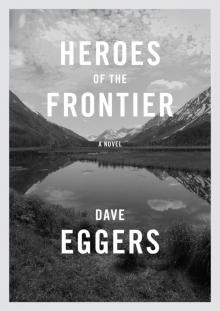 Heroes of the Frontier
Heroes of the Frontier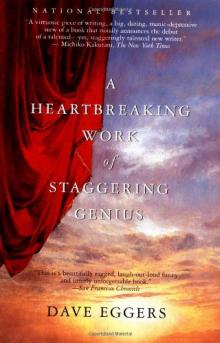 A Heartbreaking Work of Staggering Genius
A Heartbreaking Work of Staggering Genius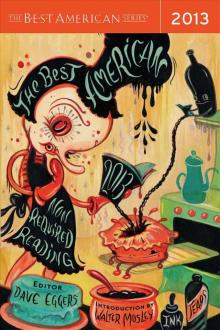 The Best American Nonrequired Reading 2013
The Best American Nonrequired Reading 2013 How We Are Hungry
How We Are Hungry The Circle
The Circle What is the What
What is the What The Museum of Rain
The Museum of Rain The Captain and the Glory
The Captain and the Glory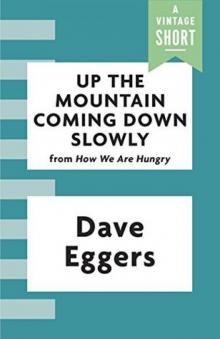 Up the Mountain Coming Down Slowly
Up the Mountain Coming Down Slowly The Parade
The Parade The Monk of Mokha
The Monk of Mokha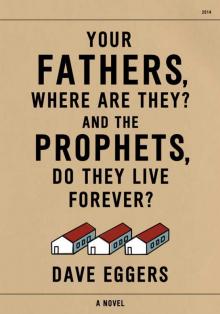 Your Fathers, Where Are They? And the Prophets, Do They Live Forever?
Your Fathers, Where Are They? And the Prophets, Do They Live Forever? You Shall Know Our Velocity
You Shall Know Our Velocity The Wild Things
The Wild Things 2006 - What is the What
2006 - What is the What The Best American Nonrequired Reading 2011
The Best American Nonrequired Reading 2011 Created in Darkness by Troubled Americans
Created in Darkness by Troubled Americans